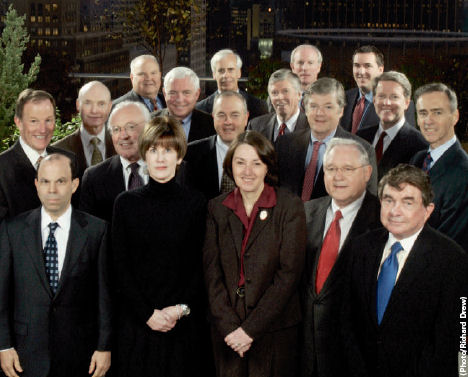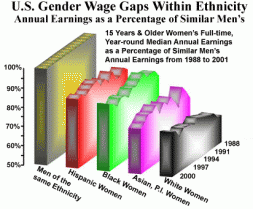Gender Inequality in the Workplace
Pay Gap

According to this picture; women make up only 13 percent of the upper level management positions, why is that?
Wage Gap

Women who work for wages are not evenly distributed throughout the United States. From 1890 about one of every five people in the U.S. paid work force was a woman. By 1940, this ratio had grown to one of four, by 1960 to one to three; and today, its almost one of two.
The pay gap is so great that U.S. women who work full time average only 68 percent of what men are paid. The gender gap in pay occurs not only in the United States but also in all industrialized nations.
Cracking the Glass Ceiling
What keeps women from breaking through the glass ceiling? The glass ceiling is a typically an invisible barrier that keeps women from reaching the top of the corporate ladder and obtaining a chair in the executive suite.
Corporations, even today are typically run by men. Capitalism is a male aspect of society, men believe that women are too emotional and less capable of leadership roles. Men tend to steer women in more human resources roles or public relations roles, where less managerial damage can occur.
Women who do learn to "crack the glass ceiling" learn to play by "men's rules". They give up sleep, recreation time, and family time. They become more aggressive and exert more masculine traits. Most of these women also have supportive husbands who share household duties and adapt their careers to accommodate the needs of their wives.
Climbing the Glass Escalator
Developed by Sociologist Christine Williams, (1995), she interviewed men and women who worked in traditionally female jobs - nurses, elementary school teachers, librarians, and social workers. Instead of bumping their heads against the glass ceiling, men found themselves aboard a glass escalator. They were given higher-level positions, more desirable work assignments, and higher salaries. What drives the glass escalator? GENDER! -The stereotype that because someone is male he is more capable.
Sexual Harassment
Not recognized until the late 1970’s sexual harassment is the unwelcome sexual advances at work or school, which may or may not affect a person’s job or school performance or create a hostile environment. Before the 1970’s women considered male sexual touches mannerisms, and pressures to be a totally personal matter not to be discussed.
Women began to realize that the issues were more than men trying to exert their attractions to women, but they were abusing their actual power over the women. By cracking the glass ceiling, women have now moved into positions of power and have also become sexual harassers. While most harassment remains male to female, the rate at which female to male is rising is growing.
